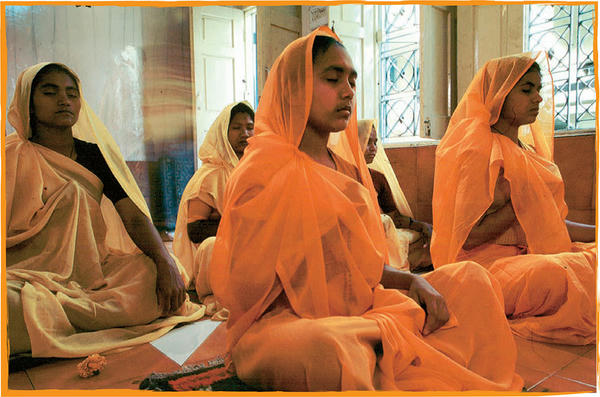43 What Is Sadhana?§
Hinduism provides many practices to quiet the mind & guide our life. Here young women sit for meditation, holding their japa beads beneath their shawl as they chant the mantras given by their guru.§
SHUTTERSTOCK§
There are three dimensions to our being: physical, emotional/intellectual and spiritual. All three need attention for optimum health. Exercise strengthens our physical body. Learning and practicing self control expands and enhances our emotional/mental capacity. Through sadhana, spiritual practice, we exercise our spiritual nature by taking time to experience it. Most of the time we are so wrapped up in our outer nature that we are hardly aware of our deep, glorious inner reality. This can go on life after life, as many people only begin to think of greater realities when nearing the point of death. We give time to our spiritual nature by performing religious activities, ideally as a daily vigil or spiritual exercise. During this quiet time alone we focus on life’s inner purpose, which is to make spiritual progress. Puja, japa, scriptural study, hatha yoga and meditation are all forms of sadhana. Some sadhanas are yearly, such as going on pilgrimage. Some may be assigned by the guru as a one-time practice. A popular sadhana is chanting “AUM” 108 times each day. The ten-minute spiritual workout is becoming popular in today’s busy world. These times of quiet retreat from life’s hustle and bustle are underrated, their benefits overlooked. Sadhana builds willpower, faith and confidence in oneself and in God, Gods and guru. It harnesses our instinctive-intellectual nature, allowing unfoldment into the superconscious realizations and innate abilities of the soul. Gurudeva noted: “Through sadhana we learn to control the energies of the body and nerve system, and we experience that through the control of the breath the mind becomes peaceful. Sadhana is practiced in the home, in the forest, by a flowing river, under a favorite tree, in the temple, in gurukulas or wherever a pure, serene atmosphere can be found.” Yogaswami directed his devotees to follow the sadhana marga, the path of religious effort, all through life.§
GURUDEVA: For consistent progress, sadhana should be performed regularly, without fail, at the same time each day, preferably in the early hours before dawn.§

